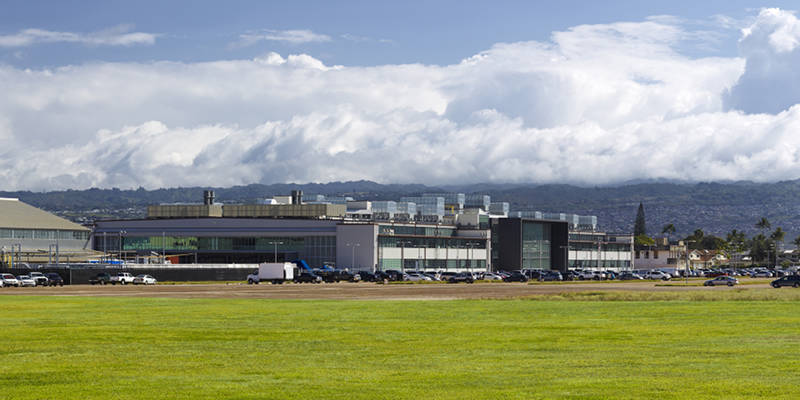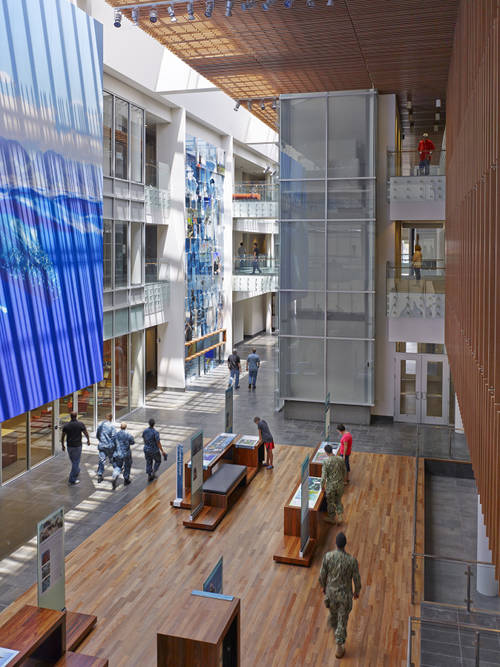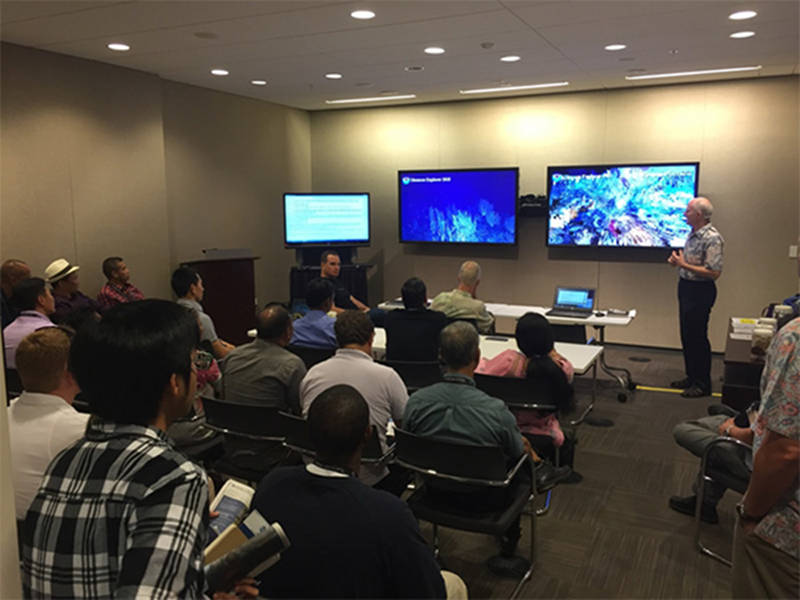
By Bruce Mundy - Fishery Biologist, NOAA National Marine Fisheries Service, Pacific Islands Fisheries Science Center
August 19, 2015

PNOAA Inouye Regional Center. Image courtesy of Alan Karchmer, NOAA Inouye Regional Center. Download larger version (jpg, 1.4 MB).
The Hohonu Moana expedition in the Hawaiian Islands has an Exploration Command Center at the NOAA Inouye Regional Center (IRC) in Honolulu. The IRC is located on Ford Island in Pearl Harbor. About 700 NOAA employees from 15 NOAA offices work at IRC, from NOAA offices that include the National Weather Service, the Tsunami Center, the Office of National Marine Sanctuaries, and the National Marine Fisheries Service. The IRC is also the home port for three of NOAA’s research vessels, as well as NOAA vessels like the Okeanos Explorer that come to Honolulu for a few years or months.

Photo of entrance to NOAA Inouye Regional Center. Image courtesy of Alan Karchmer, NOAA Inouye Regional Center. Download larger version (jpg, 1.6 MB).
I work for the Pacific Islands Fisheries Science Center (PIFSC) as a fisheries biologist. Our science center is one of six that the National Marine Fisheries Service has around the country. I’ve been at the Pacific Islands Center for 30 years. My primary interests are in the identification of fishes (taxonomy) and their distributions (biogeography). During my years in Hawai`i, I have been fortunate to have worked with many types of fishes, including their larval stages by using plankton nets, open-ocean fishes using midwater trawls, coral-reef fishes as a NOAA diver, and deep-water bottom-dwelling fishes during submersible dives and now with the Okeanos Explorer remotely operated vehicle (ROV) surveys.

Lobby of NOAA Inouye Regional Center. Image courtesy of Alan Karchmer, NOAA Inouye Regional Center. Download larger version (jpg, 2.1 MB).
My role at the IRC Exploration Command Center is to help with identifications of fishes seen with the ROV. I am one of several fish biologists who do this. Others include my colleague at PIFSC Dr. Allen Andrews; Dr. Jeff Drazen at the University of Hawai`i Deep-sea Fish Ecology Lab and Jeff’s graduate students, Mackenzie Gerringer and Astrid Leitner; Dr. Andrea Quattrini at the U.S. Geological Survey Southeast Ecological Science Center in Florida; Randy Singer at the University of Florida - Florida Museum of Natural History ; and the scientists aboard the Okeanos Explorer, Dr. Chris Kelley at the University of Hawai`i and Dr. Daniel Wagner at the NOAA Papahānaumokuākea National Marine Monument office.
In addition to identifying fishes, I have been at the IRC command center to give background information to the many visitors that we have. The IRC is on the Pearl Harbor Naval base, with restricted access, but we nevertheless have many visitors from the military, their family members, visiting scientists from other institutions, and a number of groups that have permission to hold meetings at our facility. The IRC is NOAA’s newest facility, completed in 2014. With a number of conference rooms, classrooms, an auditorium, and a cafeteria, it is an excellent facility for small government and international meetings and conferences.
The IRC command center has, on average, 20-30 visitors each day. Many are NOAA employees who work at IRC. Many NOAA employees also check the live video from the ship at their computers in their offices. During some weeks, organized tours visit the facility in connection with conferences. On one day, we had a visit from the staff of Hawaii’s Senator Brian Schatz.

NOAA Pacific Islands Fisheries Science Center (PIFSC) fishery biologist Bruce Mundy gives background information about the Okeanos Explorer Hohonu Moana expedition in the Papahānaumokuākea Marine National Monument in the Hawaiian Islands. The people in this photograph were from Asia Pacific Center for Security Studies, and were from many countries. Dr. Allen Andrews of PIFSC, at the upper left-center facing the audience, also gave talks to visiting groups about the biology of the deep-water corals and sponges seen during the expedition. Image courtesy of Alan Karchmer, NOAA Inouye Regional Center. Download image (jpg, 60 KB).
The largest group that visited was 75 people from the Asia Pacific Center for Security Studies who were at IRC for a Comprehensive Crisis Management course (for dealing with such things as typhoons, tsunamis, or earthquakes). Subgroups of 25 people from the larger group were given tours of the IRC that included half-hour sessions at the Okeanos Explorer command center. NOAA Corps Ensign Nick Pawlenko and I gave them information about the Hohonu Moana expedition and the ocean exploration program, and they watched the live video from the ship. It was a unique experience for this international group. The group came from many countries, including Pacific Island nations such as Palau and Fiji, but also as far away as Sweden and as remote as Mongolia. I suspect that this experience was the first opportunity for someone from Mongolia to see live video from a mile-and-a-half below the surface in the middle of the Pacific.
Participating in the expedition at the IRC has given me a chance to introduce many people to deep-sea research. That will continue. We will have school classes coming here in September.
I have enjoyed talking about the expedition with so many people with such different backgrounds. Even though I’m a fish biologist, not an educator, and I’m fascinated by the deep-water marine life, introducing our visitors to the deep-sea science and the ocean exploration program been the best part of my participation in the expedition at IRC.